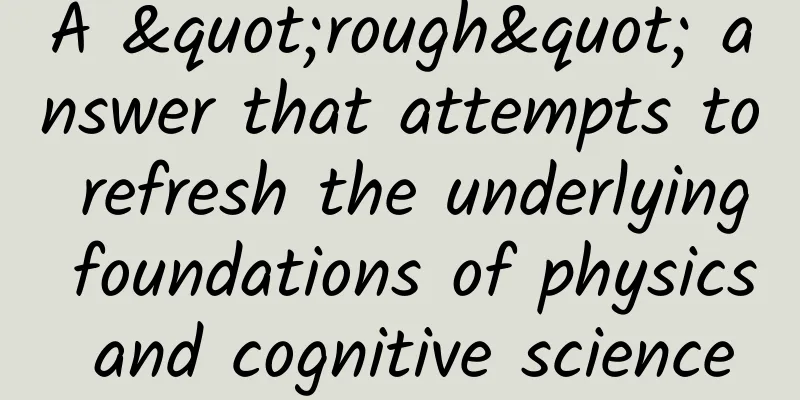A "rough" answer that attempts to refresh the underlying foundations of physics and cognitive science

|
This is a popular science book that is more brain-burning than The Matrix. The author combines quantum mechanics and biological evolution, and uses logic, experiments and computer simulations to try to fundamentally subvert the underlying foundations of physics and neuroscience. It not only gives people a new feeling about physics, but also tries to refresh everyone's most basic understanding of the world they are accustomed to. Embark on this intellectual adventure, it will stimulate your brain. Written by Qu Lijian Does the moon still exist when no one is looking at it? This is a question that Einstein asked when he was thinking about the meaning of quantum theory. How would you answer this seemingly simple question? Whatever the physicists say, Donald Hoffman, a cognitive psychologist at the University of California, Irvine, offers a rude answer in his book Seeing Is Not Seeing: When you’re not looking at it, it’s not there. Hoffman further pointed out that all our senses, including our eyes, cannot perceive objective reality at all. How can this be explained? Isn't it that we don't roll down stairs, run in front of a speeding car, grab a snake by its tail, or eat a rotten apple, all based on information given to the brain by our senses? Why can't we perceive reality? Hoffman said that what our senses show us is not objective reality, but virtual reality. We don't need to wear a helmet to experience virtual reality, we are experiencing virtual reality all the time, and it's free. To illustrate sensory virtual reality, Hoffman uses the analogy of a computer desktop. There are all kinds of icons on your computer desktop. For example, the icon of the file you are working on is a blue rectangle on the computer. You can move it, modify it, and delete it. Is this icon an objective and real file? Is your file blue? Is it located where the icon is? Is it rectangular? Of course not. None of these can describe computer files. The computer desktop is the interface for you to operate the computer. It does not show the "truth" of the computer. The truth of the computer is circuits, software, electronic movement, etc. Now imagine that your senses, every object you see, every smell you smell, every heat or cold you feel, are just icons, not the objective reality of the world. Our senses give us a user interface. Why is this happening? This user interface is the result of natural selection, designed to guide our behavior and help us survive, that is, gain adaptability, rather than to help us understand the truth about the world. Hoffman even goes so far as to argue that perceiving reality is not helpful for survival, and may even be harmful, to the point of causing extinction. This conclusion is called the Fitting Beats Truth (FBT) theorem. It is called a theorem because it is a mathematical result that Hoffman demonstrated using a quantitative theory in evolution - evolutionary game theory. Without using mathematics, Hoffman demonstrated the logical charm of evolutionary game theory in a very easy-to-understand and brilliant way. The senses of sight, smell, hearing, touch, taste, etc., are not enough to deceive us. If I reach out and grab a tomato, the tomato is not an external thing to eat - instead, the tactile experience is just the manipulation of another icon. The same is true of our perception of our bodies, the dimensions of space and time, and the small things like quarks and the large things like stars. It's like we are living in the Matrix. Does it make you feel frustrated and disillusioned? No need to be. The most important thing in life is to be happy. Hoffman devotes a chapter to explaining how to apply the concept of "sensory search for adaptability, not reality" to life and business. This part is interesting and practical, and it will inspire you in taking photos, arranging sales windows, advertising creativity and other activities. Regardless of whether everything in the world is an illusion or not, consumerist culture is real. Hoffmann claims that space, time, and objects are not objectively real either. Do physicists agree? Hoffman talked about quantum entanglement and general relativity, proving that physics does not deny the theory of sensory interface. Hoffman's argument shows that according to physics, spacetime and objects do not exist when they are not perceived. Spacetime is doomed to perish, and so are all physical objects in the world. If spacetime is not the cornerstone of objective reality, then what is it? Information, for adaptive data compression and error correction. Readers who are familiar with physics will definitely have a completely new feeling about physics after reading Hoffman's part. Of course, this does not mean that the feeling brought by this book is necessarily completely correct. Regarding the symmetry that physicists cherish so much, Hoffman said, "Symmetry reveals how we compress and encode information, not the nature of objective reality." There is no objective symmetry in the world? As a physics student, I find it difficult to accept this view. Hoffman also says that everything exists because of our observation of the universe and our interaction with it. Information, not particles and the fabric of space and time, is the source of the world. Hoffman also quotes many famous physicists to support these bold views, but does not quote any opposing views. I don't believe that there are no physicists who disagree with these views. This part is not well balanced. This part of Hoffman's content is still very exciting. I believe that Hoffman is also very inspiring for physics professionals. However, I feel that the logic from the basics of physics to the theory of perceptual interface is slightly incoherent. Perhaps Hoffman was too eager to base his theory of perception on physics, which is a more hardcore science. However, he used physics to argue that physics does not support the reality of perceived things, while at the same time he said that the origin of the world lies in consciousness. It feels a bit twisted. This book has more exciting things to say about physics. Hoffman said that since physics cannot explain the experience of consciousness, space-time and all objects are icons of consciousness, so it is natural and reasonable for consciousness to be the basis of a grand unified theory of science. This part is one of the two most exciting parts of the book (the other part is the theorem of adaptation defeating reality from evolutionary game theory), which brings excitement to people's intellectual challenge experience. Hoffman proposed a theory of "conscious agents". According to this theory, not only humans have consciousness, but chimpanzees also have consciousness, plants also have consciousness, electrons also have consciousness, quarks also have consciousness, everything in the world has consciousness, and they are all conscious agents. The universe is a social network formed by conscious agents. Conscious agents combine together to form various levels of conscious agents. For example, humans are more advanced conscious agents than chimpanzees. This combination process continues, and it is possible to produce an agent with unlimited power, that is, God, and it is possible to create scientific theology. Hoffman pointed out that any system of thought should be taken seriously and tested with our best research method, the scientific method. However, the book does not explain how to test Hoffman's theory of consciousness realism, nor does it propose testable predictions or the criteria for consciousness realism to be superior to physical realism. I feel that the falsifiability of this view is a problem. If this problem is not explained clearly, Hoffman's vision of deriving quantum gravity from consciousness realism, and even eventually explaining evolution and human psychology, and even establishing scientific theology, can only be a luxury. Of course, this is a popular science book, so we can’t be too picky. Fortunately, the book comes with detailed references, and perhaps Hoffman’s academic papers will provide more rigorous arguments. Reading popular science books is a pleasure for thinking. This book is a popular introduction to Hoffman's latest achievements in the field of cognition in recent years. The writing of the book is very smooth, allowing you to unconsciously walk from the most familiar life scenes to the forefront of academia. The most common complaint about Chinese translated popular science books is that the translation is too poor. The translator of this book, Mr. Tang Lu, has published more than 10 popular science translations, and has covered many fields. He is fully capable of handling this book and has indeed presented another excellent translation. The content of this book spans from the theory of evolution to modern physics. It is a fascinating scientific journey with clear views, brain-burning arguments, and subversive intuition. It is an intellectual adventure. Remember the red pill and the blue pill in "The Matrix"? Now you have the opportunity to make such a choice. Not reading this book is equivalent to choosing the blue pill, and reading this book is equivalent to choosing the red pill. What will you choose? 【About the author】 Donald Hoffman is a professor of cognitive science at the University of California, Irvine, and a science writer who studies consciousness, artificial intelligence, and philosophy. He is a contributor to Global Science and Frontiers magazine, and his research has been widely reported by The Atlantic, Wired, and Quantum magazine. Special Tips 1. Go to the "Featured Column" at the bottom of the menu of the "Fanpu" WeChat public account to read a series of popular science articles on different topics. 2. Fanpu provides a function to search articles by month. Follow the official account and reply with the four-digit year + month, such as "1903", to get the article index for March 2019, and so on. Copyright statement: Personal forwarding is welcome. Any form of media or organization is not allowed to reprint or excerpt without authorization. For reprint authorization, please contact the backstage of the "Fanpu" WeChat public account. |
<<: The way to achieve high image quality is to stack pixels together?
>>: Could cheap unmanned boats impact future naval battles?
Recommend
The first batch of new smart #5 was delivered nationwide. Ning Zetao appeared at the ceremony as a representative of the first batch of celebrity car owners
( November 20 , 2024 , Huzhou) Today, the luxury ...
Watch Control: Build a bridge between you and Android Wear
A week ago, after watching the Apple Watch launch...
An event planning and execution form template
one Over the years of work, I have participated i...
Is the weather forecast always a lie? AI makes the weather more predictable
We are probably accustomed to the real-time weath...
Leaking urine when coughing? This "embarrassing" disease is ignored by many people...
Expert of this article: Zhu Hongjian, Chief Physi...
Gaizhou SEO training: Keyword SEO optimization is a necessary step to accelerate the development of corporate websites
Most entrepreneurs always have such questions: wh...
If you do business well, girls won’t run away! 520 Guide to Getting Rid of Singleness, Take It, No Thanks!
Let me first share some data with you. The Nation...
Long March 3B rocket launches successfully! China's space program ends perfectly in 2021
At 0:43 on December 30, 2021, my country successf...
Surface Classroom: "From 0 to 1 Entrepreneurship Course"
Surface Classroom: "From 0 to 1 Entrepreneur...
Steve Jobs’ prediction—e-commerce
[[135753]] As early as 1996, shortly after the bi...
Boiling tea around the fire, someone got infected
When the weather gets cold “Tea brewing around th...
Does overdue mortgage repayment have a big impact? Will it be reflected in the credit report if it is overdue for one day?
Because we are currently in the midst of an epide...
Are the flowers blooming early in Beijing? Will they bloom again in the spring?
Audit expert: Yang Yanhui Senior Landscape Engine...
Guide for travel businesses to make the most of Xiaohongshu notes!
It has been three years since the outbreak of the...









